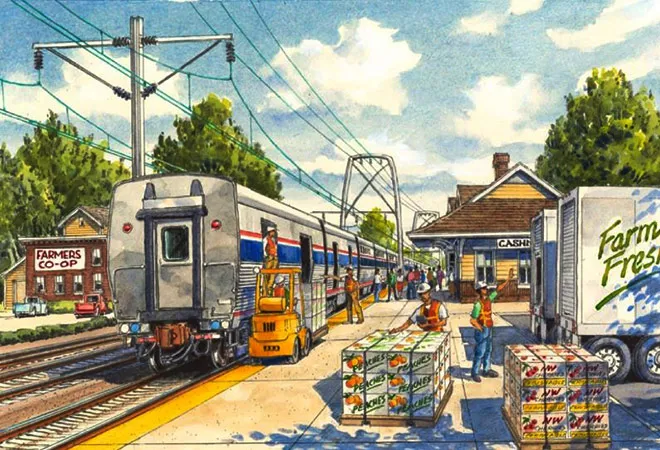
As the Budget 2021 promises significant government spending to revive the economy post the pandemic, we look at one of the most discussed measures of Budget 2020, i.e., the provisions for the implementation of Kisan Rails across the country with its intent to boost farmers’ welfare by doubling their incomes by 2022. We examine how it has shaped up in the last one year by uncovering the policy imperatives that have come along with the introduction of Kisan Rails and the economic results that the policy has reaped. In addition, we look into why steps in the present budget, such as extension of Operation Greens scheme to include 22 more perishable products, integration of 1,000 more mandis with the e-NAM (National Agricultural Market), and the facilitation of an agriculture infrastructure fund for APMCs for augmenting its infrastructure facilities are steps in the right direction.
On the face of it, the Kisan Rails seems to have struck the right chord with the farmers given its popularity, leading the government to flag off the 100th Kisan Rail within a of just four months since it was first introduced in the month of July. The idea of Kisan Rails was not completely new to the government. Successive governments in the past have mulled over the idea of capitalising on the robust Indian railway network and connect it to the agricultural sector. The idea finally took off in July this year and since then has clocked impressive volumes across the country.
The idea of Kisan Rails was not completely new to the government.
There are many reasons that could have been attributed to the Kisan Rails becoming one of the most sought-after modes of transporting agricultural produce across many routes in the country. The most important among them is the robust network of Indian railways, which cuts through the remotest villages of the country and has helped small farmers get an opportunity to connect to the mainstream market and sell their agricultural produce. Second, the government has allowed a 50 percent subsidy for the transportation costs of fruits and vegetables, thereby, making it economically viable for farmers to transport their produce through the railways rather than the conventional roadways. The Kisan Rails, on an average, save up to 15 hours of travel time and cuts the transportation cost by 1,000 rupees per tonne. Further, no minimum price or quantity requirement is set for farmers’ consignment, facilitating even the small farmers with lesser quantity of produce to reach the bigger markets. These farmers — who often could not afford the roadways and were cut off from the larger markets owing to logistical and cold storage issues — now find an alternative in the veritable cold storage on the wheels (Kisan Rails).
Kisan Rails has already transported 27,000 tonnes of goods so far in 2020, plying over routes that connect major agricultural clusters. Be it transporting small consignments such as 30 kilograms of pomegranate from Nashik to Muzaffarpur or 23 tonnes of ginger plying from Dibrugarh to Hyderabad, the Kisan Rails have given a ray of hope to marginal farmers across the country as they can avail the deserved price realisation for their products and be connected to the mainland. Kisan Rails is a step ahead towards transforming the traditional practices of purchase and sale of agricultural produce and exploring new possibilities in agriculture. This service could also be instrumental in cushioning a large section of marginal farmers from the demand-supply fluctuations as it enables farmers now to send their products to any particular part of the country, where there is demand for that crop or fruit.
Kisan Rails is a step ahead towards transforming the traditional practices of purchase and sale of agricultural produce and exploring new possibilities in agriculture.
Further, on the one hand, India today stands as the world’s second largest producer of fruits and vegetables; on the other, it has also been the country that wastes 16 percent of its agricultural produce owing to factors like inadequate logistical support, lack of cold storage facilities, supply chain bottlenecks, and under-developed market channels. The monetary worth of this wastage stands at around US$ 8.3 billion and it uses more than 230 cubic kilometers of water, which is enough to provide drinking water to 100 million people annually. The introduction of Kisan Rails has helped tremendously in reducing wastage, providing a cheaper and safer transport mode, and thereby creating a win-win situation for both the farmers and railways. The Kisan Rails, apart from directly impacting the lives and livelihoods of farmers, have also additionally helped changing smaller railway stations into major farm produce loading hubs. Kisan Rails is emerging as a profitable model for all the stakeholders involved in the process.
However, given the crucial role that the Kisan Rails could play in transforming Indian agriculture, we also must acknowledge the bottlenecks which exist and which need to be addressed as soon as possible, thereby enabling each and every marginal farmer to access its benefits. One such bottleneck has been the lengthy exercise that farmers need to undergo if they want their produce to be transported through the Kisan Rails. The product is handled in their crates at least six times — at the farm, at the source station, while loading it to the train at the source, unloading at the source, at the destination station, and finally at the mandi, resulting in increased chances of wastage of the produce. Efforts to streamline this lengthy exercise could be an instrumental step towards bringing in more traffic for the Kisan Rails. Secondly, the cold storage facility in the country needs to significantly improve and more and more stations must have cold storage facilities to maximise the potential of Kisan Rails. The government has acknowledged this issue and is proactively taking measures to ramp up the cold storage facilities in the country, which is also evident in the provisions made for agriculture in the Budget 2021-22.
Efforts to streamline this lengthy exercise could be an instrumental step towards bringing in more traffic for the Kisan Rails.
Kisan Rails has been among one of the several holistic steps that is directed towards supporting 80 percent of the country’s small and marginal farmers and to transform the Indian agriculture sector. This is a step taken in the right direction as it intends to capitalise on the robust railway network and cutting-edge technology to connect small farmers around the country and allow them to gain access to far flung lucrative markets in the country and abroad. Given the response it has received up until now, it seems Kisan Rails will play a very important role in India’s agricultural future.
The views expressed above belong to the author(s). ORF research and analyses now available on Telegram! Click here to access our curated content — blogs, longforms and interviews.




 PREV
PREV


